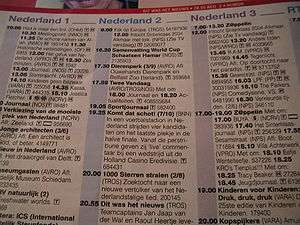Date and time notation in the Netherlands
Date
In the Netherlands, dates are written using the little-endian pattern "day–month–year" as is usual elsewhere in Europe and many other countries. Times are written using the 24-h.
- dd-mm-yyyy (10-09-2000)
- ddd. dd-mm-yyyy (za. 10-09-2000)
- ddd. d mmm. yyyy (za. 10 sept. 2000)
The names and abbr. of months and days are as follows:
|
|
Names of months and days are not capitalised in Dutch.
Time

In written language, time is expressed in the 24-hour notation, with or without leading zero, using a full stop or colon as a separator, sometimes followed by the word uur (hour) or its abbreviation u. – for example, 22.51 uur, 9.12 u., or 09:12. In technical and scientific texts the use of the abbreviations h, min and s is common – for example, 17 h 03 min 16 s.[1] The use of the 12-hour clock in numeric writing is not standard practice, not even in informal writing, and writing e.g., "1.30" for 13:30 would be regarded as odd. The actual Dutch terms for a.m. and p.m. are respectively v.m. and n.m. (voormiddag and namiddag), but these are very old-fashioned and even more rare than the use of a.m. and p.m. in written language.
In spoken language, most often time is expressed in the 12-hour clock. However, "a.m." and "p.m." are never used. Instead, an apposition is added, for instance 21:00 is said as "9 uur 's avonds" (9 o'clock in the evening). Half hours are relative to the next hour – for example, 5:30 is said as "half 6". Quarter hours are expressed relative to the nearest whole hour – for example, 6:15, "kwart over 6" (quarter past six) and 6:45, "kwart voor zeven" (quarter to seven). Minutes are usually rounded off to the nearest five minutes and are expressed relative to the closest half-hour. For instance 05:35 is "5 over half 6" (literally "5 past half to 6") and 05:20 is "tien voor half 6" (literally "10 to half to 6").
When the 24-hour clock is used in spoken language, which is not quite common, usually the written form is pronounced with the hours as a number, the word "uur" (hour) and the minutes as a number. For example, 17:21 might be pronounced as "zeventien uur eenentwintig" (seventeen hours twenty-one). Hours over 12 are not usually combined with phrasings using "half", "quarter", "to", or "past".
References
- Taaladvies: "8h30 / 8u.30 / 8.30 u. / 8.30 uur"